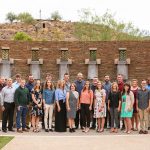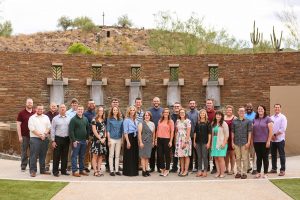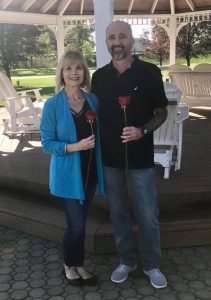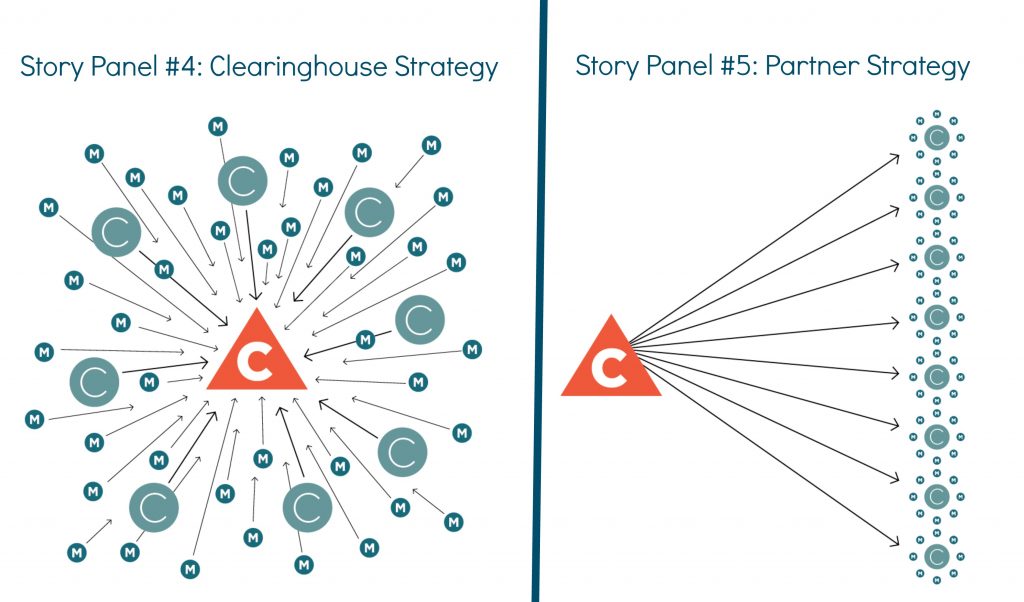Today, Christ’s Church of the Valley (Peoria, AZ) is known as one of the largest, most dynamic multi-site churches in the U.S. But during its initial expansion about a decade ago, the staff discovered a startling fact: ministry talent was in short supply, and those who enter vocational ministry do not stay. 85% of the ministry leaders who trained at our nation’s seminaries and Bible colleges left within their first five years.
“Staff longevity is a real challenge,” says CCV’s Senior Pastor Ashley Wooldridge. “Ministry is about the long game.”
That challenge impacts churches across the nation and the world, leading CCV’s leaders to form partnerships with Christian colleges across the U.S. to launch the CCV Leadership Institute in 2008.
Since then, the CCV Leadership Institute has trained hundreds of ministry leaders who are now serving in churches all across the country as teaching pastors, children or student ministry directors, sports ministry directors, small groups pastors, and worship leaders.
Young Leaders Need to Know Their Strengths
The Institute’s success, its directors believe, is rooted in its personalized approach that focuses not only skill building in each resident’s ministry area, but on his or her strengths, equipping leaders to sustain ministry for the long term.
The approach that starts during recruitment. The staff uses the Leading From Your Strengths (LFYS) profile each year as part of the application process for filling the program’s 40 available resident spots from a pool of 300 candidates.
“LFYS gives us a better idea of who the candidate really is,” says Rick Penny, CCV Director. “But more importantly, we use the information to help the candidate understand who they really are and how they can best interact with those that might be different from them.”
The profiles give clear data about the applicant’s emotional intelligence (EQ) – the ability to understand themselves and other people, and how to work cooperatively with them. “EQ will carry you in ministry,” says Steve Gross, who also serves on the Leadership Institute staff. “A strong EQ makes a ministry worker more effective in reaching people.”
LFYS was a natural choice for the Leadership Institute because the church already used the profile with its staff. It has proved to be a particularly good fit when training vocational ministry leaders for the long haul.
The Biggest Misconception Debunked For Ministry Leaders
Over and over, the profiles have revealed a recurring misconception among would-be ministry leaders: only the dynamic, outgoing, visionary personality is effective as a ministry leader. “We have had to work with more than a few candidates to help break that misconception,” says Rick. “LFYS has helped them embrace who God made them to be as a leader.”
Enrolled residents work with the Institute staff to assess the jobs, roles, and tasks they are considering in ministry and align those results along their profile data to understand where they can best fit to operate out of their strengths. Although the young leaders-in-training are still learning to understand their strengths and acquire the skills to apply them, the LFYS process provides a living laboratory for the resident to do so while working hands-on with CCV staff. Meanwhile, each CCV staff is acutely aware of their own profile data and each other’s, allowing them to model strengths and team blend.
“The Leadership Institute is committed to ‘growing’ who the residents are,” says Steve. “Not ‘changing’ who they are.” There is rarely a time when residents and CCV staff enter into a new area, task, assignment, or interaction without at least considering the profiles and how each resident’s data might come into play. “The awareness helps avoid a lot of misunderstandings, while bringing a bigger sense of fulfillment to the workplace,” says Rick.
“The Leadership Institute at CCV not only challenged and strengthened me as a ministry leader, but most importantly as a servant leader in Christ’s Kingdom,” said alumni Jomarie Manimtim Olander, who has since served in children’s ministry and as a campus coordinator. “I got to work alongside ministry leaders and staff members who really care about me as a person and who helped prepare me for a lifetime in ministry.”
When pastors and other ministry leaders are aware of their strengths, they can lead well from a place of confidence. “I cannot imagine a team leader operating without the Leading From Your Strengths profiles,” says Rick. “We have seen nothing but benefits from using them. To all leaders out there, I say give the profiles a shot.”
More About Developing Ministry Leaders
Leadership: Building Up Leaders Down Under
Leadership: A Tale of Two Leaders
Leadership: If a Tool Is Easy and Good, Why Not Use It?
Al and Lori Elmore have been married for more than three decades and describe themselves as “happily incompatible.”
Their enthusiasm for healthy relationships is evident in the marriage classes and retreats they’ve led over the years, which took an exciting turn when they were introduced to the Different By Design (DBD) curriculum.
The Elmores first learned about DBD at a marriage retreat in 2011 with Rodney and Beth Cox. Since Al is a pastor, he decided to attend the 2012 Ministry Insights Equipping Conference to learn further about DBD and Leading From Your Strengths (LFYS). Al and Lori attended the conference again in 2017, this time together.
Then they incorporated the DBD material into a weekend retreat for 28 couples in Ohio’s Amish country, sponsored by Lima Baptist Temple, their home church. Participants registered through the church website and received a confirmation email with their Marriage Insights passcodes so they could have their profiles completed for the weekend.
“DBD helps couples to discover and value their strengths and differences and to develop oneness with each other and God,” says Lori. “The marriage retreat and DBD were a useful springboard to help couples communicate better and understand each other.”
Breakthrough Truth: “I Don’t Need to Change My Spouse!”
That springboard in a beautiful autumn setting created a powerful environment for marriage breakthroughs at the retreat.
“We don’t need to change each other!” That was a big discovery for Bob and Michelle. Prior to the retreat they were aware that they had differences, but the profiles gave them a clarity as to the strengths each brings to their relationship. Both husband and wife came away motivated to value the strengths in their spouse.
“The most important thing I learned at the marriage retreat is that 1 + 1 = 1,” says Michelle. “I want to work very hard to make sure Bob knows how much I love him and how important he is to me.”
That contagious enthusiasm also impacted Joe and Susan. They had been in marriage counseling before the retreat, admitting they felt isolated from each other and focused on their children. During counseling, they had completed the profiles and were aware of each other’s strengths but had not put the data to use. But it was during the retreat that they were inspired to take a step forward.
“Before digging into DBD, we recognized that we were very different from one another,” Joe and Susan shared. “But now, we want to work on understanding our differences and appreciate the strengths in each other so we can be united as one.”
Breakthroughs Begin with You
In addition to DBD and the Marriage Insights profile, Al has used the Leading From Your Strengths process with his staff. “The profile helps you understand why people act a certain way or handle responsibilities a certain way,” says Al. That’s a big reason he recommends the entire Ministry Insights suite for work teams, employers, coaches, and counselors who lead staffs, counsel couples, or speak at retreats and conferences.
Both Al and Lori stress how firsthand experience with Different By Design and the Marriage Insights profile gave them the foundation to lead others to marriage breakthroughs.
“DBD is a great tool to help you and your spouse understand and affirm each other,” says Al. “Do it yourself and you’ll see.”
Special Offer – Limited Time: Different By Design Curriculum 45% Off Through February 28
As a special offer to our readers and as a way to encourage couples in their marriages, we’re offering 45% off the Different By Design bundle now through February 28. The bundle (regular price $64.95) includes the Different By Design DVD, 2 workbooks (1 for each spouse) and 2 Marriage Insights profiles (1 for each spouse). Order your bundle here.
More about Building Marriages
Marriage: Counselor Jimmy McLeod Invests in Marriages and Teams With Profiles
Marriage: Financial Advisor Uses Universal Message to Build Marriages
Marriage: Love & Money – and Interview with Rodney Cox and Don Blanton
One Multisite Church’s Story of Simplifying Communications
Guest Post by Judy Stallwitz
Our staff loves each other. We’re a healthy team that balances humility and willfulness.
 But just like maintaining a healthy diet or a healthy marriage, maintaining good team health requires attention to drift.
But just like maintaining a healthy diet or a healthy marriage, maintaining good team health requires attention to drift.
“Drift” isn’t a mystical cloud that materializes. It can easily tiptoe into a staff when we’re distracted from our goals and values by anything… even good things. One indicator of an organization’s health is how the staff handles communications. What do we expect and what do we deliver? Day-to-day stresses reveal our actual values.
Recognize Drift When You Monitor Your Communications
Several years ago, our staff at Hillside Christian Church experienced some drift. Multisite growth is both exciting and challenging – and our church was growing like crazy. Yet we were responding to important growth needs at the expense of certain operational needs.
When I say we, I begin with me.
The Communications Team was feeling the heat. We were inundated by requests that were often last-minute or lacking coherence.
We were communicating how difficult the situation was becoming, yet the stress began creeping into staff interactions. My flawed assumption was that everyone from all campuses and ministries should see the issues and adjust. How could they miss it? I wondered.
Finally, I was able to shift my viewpoint and ask a better question: how can we work together as a healthy team and avoid this difficult situation?
A Healthy Team Tells the Story Together
As communicators, we lean on the power of story to communicate urgency to our constituency. Even so, we can neglect to utilize the power of story in our work context.
Why not tell the story as a team? Our story was about a vending machine.
We took that approach and combed through all the data that showed the scope of work: the annual number of requests, the average lead-time, and the project load according to campus and ministry areas. Since we had begun to refer to our current communications request process as the unending vending machine, why not use that image as our story metaphor? And just like that, our little communications “Dorito” icon (The Dorito C) was born.
Here’s a sampling of some of our story panels.
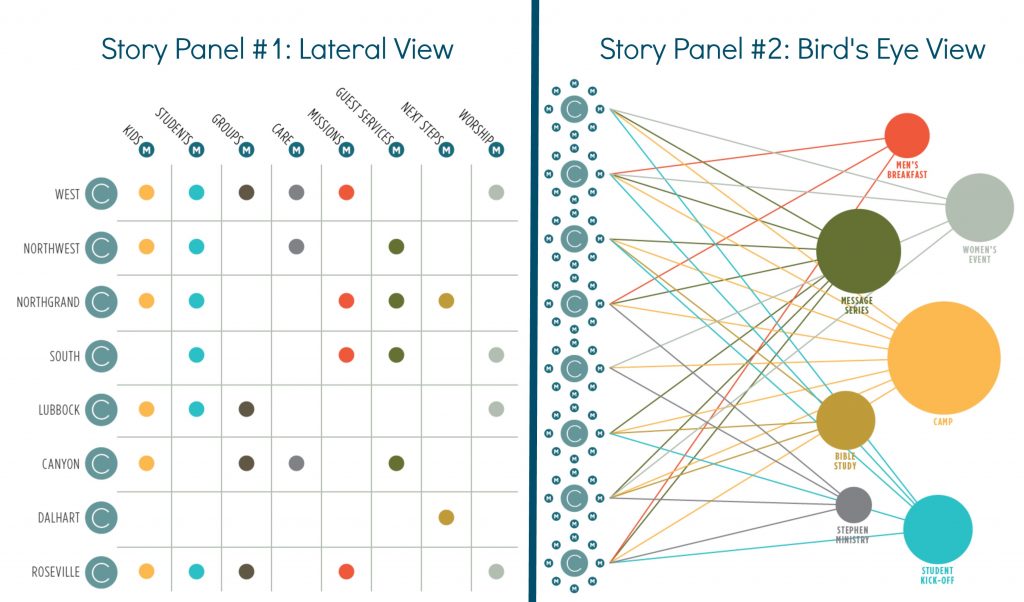 The first image illustrates how ministry teams can see straight down their own calendar line, unaware of other lateral events of other ministries (Story Panel 1). Meanwhile, the communications team experiences the tension of the organization’s scope because they have a bird’s eye view in their daily environment (Story Panel 2).
The first image illustrates how ministry teams can see straight down their own calendar line, unaware of other lateral events of other ministries (Story Panel 1). Meanwhile, the communications team experiences the tension of the organization’s scope because they have a bird’s eye view in their daily environment (Story Panel 2).
 How can a communications team help all the ministry stakeholders develop this kind of understanding? Communications – the Dorito C’s – assume all stakeholders are aware of the scope of ministry. Yet the requests continue to pour in. Overwhelmed and resigned, The Dorito C team continued to respond to every request possible using its vending machine strategy (Story Panel 3).
How can a communications team help all the ministry stakeholders develop this kind of understanding? Communications – the Dorito C’s – assume all stakeholders are aware of the scope of ministry. Yet the requests continue to pour in. Overwhelmed and resigned, The Dorito C team continued to respond to every request possible using its vending machine strategy (Story Panel 3).
Unbridled input from every angle feels as bad as it looks. Without a purposeful communications strategy, the team is positioned in the center of a circle, like a clearinghouse, with everyone firing requests toward the center. Teams begin to exercise the reflex to grab what they can get. Resentment can build from unintentional, unrealistic, or unmet expectations (Story Panel 4).
One simple shift changes the process. The communications team moved its position from receiving data in the middle and instead, partnered with each unit in the planning process (Story Panel 5). This creates an environment where ministry teams and the communications teams align their expectations and build margin into the process.
A Healthy Team Makes It Work Tangibly
The approach brings scope clarity to all stakeholders.
It takes time. It takes intentionality to gather teams beforehand to plan their ministry season. It takes compromise at the table. It takes grace. But this cooperative approach creates a space where our best – everyone’s strengths – are featured as people work together.
To set the shift into motion, first we met with teams and told the story of our current landscape. Then we painted a picture of how advanced planning on a multisite scale could operate, emphasizing that it would take energy on everyone’s part. But we offered more than simple good will to sweeten the deal: our communications team (The Dorito C’s) would synthesize all the information for the ministry calendar and deliver a comprehensive plan including the delivery schedule of all products for everyone.
Think of this as writing a budget for your family instead of living paycheck to paycheck… with teenagers… who have debit cards.
A Healthy Team Makes the Time to Plan Together
We’re blessed to work with discerning leadership. Our directional team had already begun identifying the source of the problem and considering planning solutions. They partnered with our efforts for real results. They enhanced and championed the plan and provided the kind of support every team dreams for during a big change. They asked us to present “The Vending Machine” to all campus and ministry team leaders in one big, fun get-together.
Every person who attended that meeting lit up with possibility and threw in valuable suggestions. The team was in! This energized coalition of leaders took the vision to their ministries and campuses and we’ve operated successfully this way for over two years.
When I talk with multisite teams who haven’t implemented a framework for advanced planning, the common answer is, “We’re thinking about it.” That’s usually code for, “When we find the time.”
Make the time. Your situation is unique and your approach to planning may vary, but it doesn’t change the truth:
Healthy teams plan together.
*This post first appeared on The Unstuck Group’s blog.
More about Team Building
Teams: 4 Questions to Ask about Your Church Communications
Teams: Why Guess About Each Other When You Can Know Each Other?
Team Exercise: Do Differences Divide Your Team or Unite Your Team?
“Fifty percent of my time is dedicated to leadership development,” says Steve Bush, who joined the staff of Real Life Christian Church (Clermont, FL) as administrative pastor after more than four decades in business.
From his experience as a CEO, business development director, and manager in the agricultural supplies industry, Steve knew he needed a legitimate, proven tool to use with the Real Life team, particularly with its leaders – now numbering 100+.
He found one in Leading From Your Strengths.
The Profile Beta Test
The Real Life team had been using other assessments for employee development (including DISC, Strengths Finder, and ARNO), but nothing that adequately addressed leadership. “We needed a way to create a profile for our leaders to use in training and coaching,” says Steve. “One that targets each person’s strengths and weaknesses versus a ‘one size fits all’ approach.”
They came across Ministry Insights and Leading From Your Strengths through an internet search and decided to beta test the profile on a few staff leaders.
“We liked what we saw,” says Steve.
His own profile report accurately defined how Steve manages change and information in order to make sound decisions, confirming that he needs a good lead time to process information before using it. Steve shared this information with staff members who report directly to him, and he noticed that they made adjustments immediately.
Steve began referring to individual staff member profiles before starting a project. “The profile helps me know how each person will likely approach an assignment,” says Steve. “That shows me the best ways to delegate those tasks.”
Profiles Yield a Valuable By-Product
The leadership team invited Ministry Insights president Rodney Cox to travel to Florida and conduct a workshop for Real Life’s leaders. “That was a significant step in adopting LFYS for our staff,” says Steve. The written reports and Strengths Wheel gave team members concrete data to use to improve productivity.
Because of the information it shared and is so accurate, each team member better realized their differences and is willing to embrace those differences. In setting out to equip the church’s leaders to use their strengths more effectively, Steve and the Real Life team discovered a valuable by-product – one that Jesus desires for his people: unity (John 17:21).
“Our teams have become stronger and more effective by using the data from the profiles,” says Steve. “The end result has been unity on our team … which interestingly, is one of our core values.”
Soon, all 133 Real Life employees and many volunteer leaders on all 7 Real Life campuses had completed the assessment. “Today, using the Leading From Your Strengths profile is standard operating procedure for the church’s leadership development strategy,” says Steve.
Along the way, LFYS has become part of Real Life’s selection process for every new employee, too.
“It’s a great leadership tool,” says Steve. “We’re glad God led us to it.”
More About Leadership Development with LFYS
Leadership: Building Up Leaders Down Under
Mistaken Identity Leads Ministry Director to LFYS Profile
“I discovered Leading From Your Strengths by accident,” confesses Roger Orman, a director with the Mississippi Baptist Convention Board. “It was a case of mistaken identity.”
For years, Roger had used Gallup StrengthsFinder in his work as a pastor and later as Associate Director of the South Carolina Baptist Convention. But when he transitioned to his new role in his home state of Mississippi, a colleague approached him with a request. The colleague had completed a strengths profile as part of seminary training. Could Roger help him interpret it?
Both men assumed the assessment was those Roger had processed for years with other ministry workers.
It wasn’t.
“Leading From Your Strengths was different,” says Roger.
Like other assessments, the profile addresses the user’s natural strengths but to Roger, the adapted strengths reporting was new and exciting. Adapted strength data indicates how much the user adjusts his natural strengths to match the requirements of a specific environment, such as work, your family, or your ministry.
His interest piqued, Roger took the assessment for himself.
Natural Strengths Nailed
He was stunned. Roger’s profile revealed his introverted nature, a trait that no previous assessment had identified and one that few people know about him. “I was a theatre major in college and a local church pastor for many years. I am used to ‘performing’ in front of people, so they naturally think I am an extrovert,” says Roger. “The profile nailed me.”
It was at that point that “I knew Leading From Your Strengths is really, really good,” he says. “And then, I simply had to learn more about it.” Roger attended the Ministry Insights Equipping Conference where he became certified.
There he discovered another beauty of the profiles: their accessibility. While it is extremely helpful for a user to work with a certified coach to interpret the profile’s results, any user can read and use the data. “The profile just makes sense,” he says.
He now sees the profile as a valuable tool both in his own ministry personal toolbox and one that can bring value to teams.
Interpreting Adapted Strengths in a Living Laboratory
Roger brought the profile to the attention of his supervisor and subsequently processed it with other members on his team.
As they worked, fellow director Johnny Ervin noticed that the content was familiar. He soon recalled that he had completed Leading From Your Strengths three years earlier.
“It was a perfect opportunity for me to work with him to see how his life circumstances impacted his adapted strengths,” says Roger. “I was in a living laboratory.”
Johnny’s church planting position and responsibilities had changed in the three years between assessments. He had moved into semi-retirement. While his passion remained in startups, now his focus was on coaching new church planters.
Johnny’s updated profile reflected that change. “He now had lower adaptive strength numbers compared with the first report,” says Roger. “He understands who he is and he is using his natural strengths in his new role helping young planters have strong starts.”
The Profile Is a Snapshot in Time For Teams
Roger is now planning a retreat to equip Mississippi Baptist Convention Board leaders to present the profile to churches across the state as a tool they can use to build strong staffs.
“Teams and leaders need to know their strengths, says Roger. “But there is more to successful team work than that.” He sees tremendous value in leaders and their staff member completing the profile again every couple of years as a team to better understand how they are adapting.
“The profile offers a snapshot in time for teams,” says Roger. “Life events, circumstances, and environment alter how we use our strengths. If you maximize how you adapt, you can lead from your strengths.”
More About Team Building
Leader Uses Profiles to Onboard New Team Members
Teams: Why Guess About Each Other When You Can Know Each Other?
Pastor Uses Profiles to Help Transition Teams and Leaders Transition
Ministry Consultant Uses Profiles to Build Teams in Transition
“I have a confession,” says Scott Mawdesley, then a campus pastor with 12Stone Church in Georgia. “I use the Leading From Your Strengths profiles differently from other leaders.”
Scott hit on a powerful facet of the profiles: their versatility.
It was during a break from ministry when working in the consulting world that Scott got acquainted with Rodney Cox and the Leading From Your Strengths profiles, becoming certified in the process. Later, when he returned to a position in a local church, Scott put the profiles into practice with his team.
While other church leaders draw on the profiles for vetting candidates for a position and in team building, Scott has found a unique niche for the profile data – one that fits his entrepreneurial approach to leadership. He uses them to onboard new staff.
Use the Profiles to Onboard New Staff
Scott’s intuitive nature means he can identify a candidate who is a good fit early in the hiring process. Rather than asking several job candidates to complete the profile, he waits until a hire is selected. “At this point, I am confident that this person fits the role,” says Scott. “I’m not worried about our team being comfortable with the person.”
As part of the transition, Scott asks the new team member to complete the Leading From Your Strengths profile. The profile data becomes a tool for Scott to use to facilitate the staffer’s onboarding to the team and into the work environment. He uses the data to understand the nuances of the new employee’s personality at the front end so they can work best together from the start.
Scott has found the profile especially helpful when it comes to specifics about communication: What might she wrestle with? How can he affirm her? What does she need to know when it comes to change or lack of clarity?
“The profile data lets me do my best to help the new employee integrate into the system and culture,” says Scott. “I can say, ‘Hey, I know X element of our work environment will be comfortable for you, but Y may be uncomfortable. I’m here to talk about it if you need to.” That kind of heads-up keeps staff members from being blindsided and helps them move into their new roles more easily.
Use the Profiles to Coach Staff Members
Scott has also found the profiles to be helpful as he coaches his staff members to use their God-given strengths and be stronger for it individually and together. Such was the case when he was asked to take on a new position in an organization. As he made the transition, Scott asked an assistant to move with him.
Although the assistant handled her new responsibilities the best that she could, the new fast-paced setting required attention to detail – and her strengths did not fit that environment.
Scott was familiar with the assistant’s profile data, so he was able to assess the situation sooner than later. One day as he faced an urgent deadline that required his team’s immediate response, Scott realized that his assistant couldn’t help him finish in time. She simply did not have those particular strengths.
“I couldn’t change the work culture,” he said. “And she couldn’t change herself to fit the culture. She had other strengths that needed to be used in the organization. I wanted to coach her to use them.”
That was a turning point that allowed Scott and his assistant to have a series of conversations that led her to move into a different role in the organization. Scott subsequently hired a new assistant that was better suited to the fast-paced environment dictated by his position.
Use the Profiles in Ways That Work For YOU
Scott has used the profiles in off-site team retreats and in team-building exercises, but he has found them to be most productive in transitioning new members onto a team and coaching team members to use their strengths.
“The profiles don’t dictate whether or not I hire a person,” says Scott. “But they guide me to help team members use their strengths. They’re a great tool for leaders, no matter how you choose to use them.”
More Staffing Tips from Ministry Insights
Pastor Uses Profiles to Help Leaders Transition – Even Himself
Church Staffing Transition: Don’t Marry Rachel and End Up with Leah
Ministry Consultant Uses Profiles to Build Teams in Transition
Use this team devotional as a short Bible study or exercise during one of your regular team meetings.
For You From the Word
 Encourage one another daily, as long as it is called “Today,” so that none of you may be hardened by sin’s deceitfulness. (Hebrews 3:13, NIV)
Encourage one another daily, as long as it is called “Today,” so that none of you may be hardened by sin’s deceitfulness. (Hebrews 3:13, NIV)
For You To Think About
Read Hebrews 3:13 aloud together.
Encourage Each Other
- The word “encourage” used here implies coming alongside another to urge them on. Think of a situation in which a team member encouraged you. How did you feel?
- Why is encouragement so powerful?
Encourage Each Other Daily
- The writer of Hebrews cautions us to encourage each other daily in order to prevent our hearts from hardening. Why can it be easy to begin to take for granted each other’s strengths – and what can happen when we do? Give a clear example.
- Why does God specify that we are to encourage each other daily, rather than just once in a while?
Encourage Each Other Today
- Think back to the time when you first learned about your team’s strengths. What was one strength in another team member that had special meaning for you? Share your thoughts with the person and with the group.
For You To Pray
Heavenly Father,
Thank you for the strengths represented on this team. Today, I especially thank You for [allow team members to give thanks for specific strengths represented on the team.]
Help us to encourage one another. We do not want our team to become hardened to each other but rather we want to be soft and open to each other so You can use us best. Remind us daily to appreciate the strengths You have placed on this team. Begin with me.
In Jesus name, Amen.
More Team Building Tools
Team Devotional: We Complete Each Other
Coffee Debrief: An Exercise in Meaningful Interaction
Team Exercise: Do Differences Divide or Unite Your Team?
Russ Olmon and Lake Pointe Team are Accountable to Know Each Other’s Strengths
“Pastors have two choices when it comes to managing staff,” says Russ Olmon, multi-site pastor at Lake Pointe Church in Rockwall, TX. “You can believe that you’re gifted at guessing at how God has made people. Or you can know who you are working with by using a tool that is objective and biblically-based – one that has been shown to have been blessed by God.”
The tool Russ refers to is the Leading From Your Strengths profile assessment, which he and his Lake Pointe team have embraced as an institutional standard over the last 15 years.
“Why guess about people – when you can know them?” says Russ.
Value the Strengths of the People on Your Team
“We want our ministry to thrive. That means we want our team members to thrive in their positions,” says Russ. “To do that, we need to know their strengths and set them up for success.” Each Lake Pointe team member completes the profile. Many departments post their team’s Strengths Wheel on staff cubicles, reflecting team members’ strengths. In fact, individual differences are valued so highly that staff members and supervisors are responsible for knowing each other’s strengths and using the strengths wheel data as they relate to one another in their day-to-day work.
The leadership team reviews staff profiles regularly, especially to ensure a good fit when they are considering moving a team member into a new position or department. Even potential staff candidates complete the profile assessment as part of the interview process.
“Our people know how to talk with each other well,” says Russ. “Conflicts may arise from competence or other issues, but our team knows how to communicate because they have the tools they need from their profiles.” Profile data helps the staff to circumvent many of the usual communication problems so common on teams, allowing Lake Pointe personnel to focus on ministry instead.
Value the Strengths of the People You Lead
Russ espouses the same approach to the profiles in his role as president of Ministry Advantage (MA), a coaching and equipping ministry for leaders which grew out his own personal need. After beginning work as a pastor, Russ discovered his seminary training prepared him well in theology, preaching, and teaching – but did not address skills in communicating, developing teams, and interacting as a leader with different kinds of people. Ministry Advantage steps in that gap for ministry leaders.
A partner brought the Leading From Your Strengths profiles to Russ’s attention around the time of Ministry Advantage’s launch. Once Russ completed his own assessment and saw its benefit, he and his team integrated the profile into all MA coaching and training. Each client completes the profile before his or her coaching session. “This way, the coach knows who they are coaching and knows how to communicate with him,” says Russ. “The profiles have tremendously enhanced our ability to coach ministry leaders.”
Leading From Your Strengths has impacted Russ’s personal life as well as his ministry life.
When his son, Stephen, entered adolescence, Russ asked him to complete the profile. The results shocked Russ – and transformed his relationship with Steve. “I work hard and then play when I’m done,” says Russ. “Often I don’t leave enough time to play.” But Steve is wired to have fun along the way. Russ had assumed their conflict was one of values, but the profile revealed the two Olmons had different strengths. Russ realized he might alienate his son if he didn’t change the way he was leading as a father. The very next weekend father and son set about washing the car, and Russ turned the water hose loose on his son. Steve was shocked – and thrilled. “That experience became the basis for one way I related to him from then on,” says Russ. “The profiles changed everything. We get things done, but we always have fun.”
Bottom Line: Value Other People
At the core, Russ believes the profiles reflect a biblical truth: we are to esteem each other.
“God says each of us is ‘fearfully and wonderfully made,’ and everything God makes is good,” says Russ. “With the profiles, leaders can know what their people are like and how to relate to them with respect. You don’t need to guess.”
It’s a tool that helps bridge interpersonal issues that arise so often in ministry. “It works,” says Russ. “Who doesn’t want that?”
More Tips for Building Your Team
Exercise: Do Differences Divide Your Team or Unite You Team?
Ministry Consultant Uses Profiles to Build Teams
Insights are short, biblical truths to equip you to lead from your strengths.
Are you task-oriented or people-oriented?
Each of us has a natural way we interact with your environment. This God-given inclination falls into one of two different orientations.
The task-oriented among us are interested in “getting the job done.” They’re list-makers and sequential thinkers who function well when completing a task and moving on to another one. Meanwhile, those that are people-oriented do their best work when they interact with others. They thrive in relating to people, cooperating together to accomplish tasks, and building relationships.
These two different orientations bring strengths to a team, a family, and a marriage.
Here’s an Insight
Both task-oriented strengths and people-oriented strengths are valuable in kingdom work.
Take a look at how God used these two different orientations working together in the early church.
Paul was a task-oriented Persuader. His interest was in “getting the job done” – telling people about Jesus. He visited a village, presented the good news, led people to faith, and launched a cell of believers. Once he had accomplished those tasks at a given location (or he was run out of town), Paul moved on to the next town. God had gifted Paul with the ability to communicate enthusiastically and convincingly, leading many to faith in Jesus Christ. He was a change agent.
In Corinth, Paul connected with Aquila and Priscilla – two people-oriented Relators/Promoters. The couple hosted Paul in their home and shared their tent-making business with him. Clearly Aquila and Priscilla supported and encouraged Paul, because they traveled to Ephesus with him. There they coached and counseled the Ephesian believers, even singling out Apollos for special discipleship when they discovered his leadership gifts. The couple’s home was a revolving door of hospitality and encouragement. God used them to nurture believers – in particular the leaders of the early church. Their relational orientation was so strong that Aquila and Priscilla were willing to risk their lives in order to invest in God’s people.
Use Your Natural Orientation
Paul completed tasks, but he also knew the job of building the church was not done.
He partnered with Aquila and Priscilla, who took the baton from him, built up others in the faith, and even discipled other leaders.
As you consider your orientation to your environment, think about your most natural approach: task-orientation or people-orientation.
How do you use your natural orientation on your team or in your home to build God’s Kingdom?
Discover your strengths when you take the Leading From Your Strengths profile.
More Insights About Strengths
Conflict: Use Your Adapted Strengths to Resolve Conflict
Conflict: It Can Lead to Multiplication
Conflict: Must Two Similar Personalities Always Lead to Conflict?
Conflict: Diffuse Jealousy By Blending Strengths
Change the Way You Think, Part 2
Change the Way You Think, Part 1
Parenting Insight: What’s Your True Parenting Insurance Policy?
Do You Know Your Strengths … Or Are You Just a Know-It-All?
Renewing Your Mind Means Choosing With Your Head
Changing Your Heart Means Giving God Access
By Gary Warkentin, Effective Ministry Teams
We often hear of teams dealing with adversity, particularly athletic teams. Interviews with sports figures describe how their team overcame hard times to win. The responses generally include sticking together as a team, not giving up, and not losing sight of the goal. Many say that adversity has also made their team stronger.
A good friend of mine, one who shares my journey through bladder cancer and chemotherapy, encouraged me to write this article to describe my own experience in overcoming adversity. While my challenge is personal, some of the lessons learned can be helpful to ministry teams facing adversity.
Team Unity Offers Strength During Adversity
Adversity is not something to be faced alone. There is strength in team unity during adversity. Each person on your team brings different strengths to the table when dealing with hardship. It is actually the blend of these strengths that brings the team through adversity.
In my case, my family is the team that is helping me navigate through my challenge. This includes one person in spirit who is Jesus Christ. He embodies all the strengths necessary to overcome adversity.
Team unity is essential to overcome adversity. In our family team, our love and commitment to each other have been the most important unifying factors. How we view our differences is key to team unity. Effective teams don’t just overlook their differences, but they actually embrace and value them. Valuing differences brings strength and unity rather than conflict. A team’s commitment to each other and their goals will help them overcome adversity. This is particularly important to know because our natural tendency when facing adversity is to try to find blame.
Patience and Endurance are Part of Adversity
In addition to team unity, overcoming adversity requires patience and endurance. When we are dealing with difficulty, it is not always clear how long it will last or how we will get through it. We need to be patient and not give up. Adversity can actually develop these character traits. The Bible also addresses this issue in James 1:2-4: “When troubles come your way, consider it an opportunity for great joy. For you know that when your faith is tested, your endurance has a chance to grow. So let it grow, for when your endurance is fully developed, you will be perfect and complete, needing nothing” (NLT).
Team Members’ Strengths Help You in Adversity
The strength scales from the Leading From Your Strengths profile gives us a framework for different ways of dealing with adversity.
Some people see adversity as a problem and charge ahead and aggressively try to fix the problem. Others will be more reflective and try to determine the cause and chart a path through the adversity. In my case when we received the cancer diagnosis, my family’s initial response was shock and sadness. Yet soon their individual strengths became apparent. One of my son-in-laws was quick to focus on beating the cancer, while my wife and daughters were focused on the details of how we were going to get through the immediate treatments.
Team members will have different perspectives when difficulty comes. Some will be optimistic and some will be more realistic. Some will be more trusting and accepting of medical advice while others are more cautious and want to validate advice.
Adversity involves change that is not predictable. It is unexpected. When things are going well, we think that adversity will never come. People who are more dynamic tend to take adversity in stride, while people who are more predictable try analyze the trial and often ask why. For example, one son-in-law reminded me of the goal and God’s promises; meanwhile my son asked “Why?” and questioned the fairness of my illness.
Facing adversity is much like facing risk. The outcome is uncertain. Pioneering people want to try new things to overcome the adversity while structured ones feel it is best to stick to the basics and closely follow procedures.
Each of these strengths or approaches to adversity have value, but it is the unique blend in a team that help them overcome challenges. Team members must value the strengths of their team mates. In my case, when I felt discouraged, scared, and helpless, the strengths of different family members completed me in my weakness. My innocent granddaughters made encouraging cards for me … one of my daughters helped arrange for meals to be brought to us. The very presence of my family met my needs.
I am blessed to be part of a family team with many different complementary strengths – all the way from 6 lovely granddaughters to 3 loving and supportive adult children and their spouses to a caring and encouraging wife. They have been extremely helpful to me tin facing my adversity.
As you navigate adversity, consider your team’s strengths. Lean on them. And be ready to use your strengths to support them when they face adversity, too.
More about how other ministries use profiles and curriculum
Financial Advisor Uses Universal Message to Build Marriages
Tony Husted on Coaching the Coaches With the Profiles
Counselor Jimmy McLeod Invests in Marriages and Teams With Profiles
CEO Uses Profiles to Build His Team — and Others
Coaching: Life Coach Guides 20-Somethings to Identity and Purpose
Transitions: Canadian Leader Helps Midlifers, Teams Transition Well
Versatility: Pastor, Educator Uses Profiles Across Ministry Areas
Using the Profiles: Adventure Kit Helps Children Discover Their Strengths
Coaching: Ministry Consultant Uses Profiles to Grow Teams
Profiles Help Grow Young Leaders in the Latin American Church
Coaching: How to Help People Apply the Profile
Leadership: Building Up Leaders Down Under

